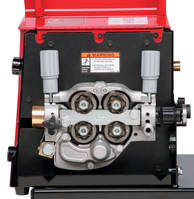If your MIG wire isn’t feeding smoothly, there are a few key things to consider. This MIG welding troubleshooting guide will walk you through the most common MIG welding issues and how to resolve them.
 Are you using the correct drive rolls for the MIG wire diameter and type that you’re running?
Are you using the correct drive rolls for the MIG wire diameter and type that you’re running?
Most all manufacturer’s drive roll kits will allow you to run two different wire sizes. If the drive rolls are flipped over to the wrong side for the wire you’re currently using, it may put too much tension on the wire causing it to deform and feed improperly.
Also, be sure you are using the correct type of drive roll for the wire. There are 4 different kinds of drive rolls which are used for different types of wire. Base your selection of drive rolls upon the following recommended usages: V grooved for hard wire such as AWS ER70S-6, U-Grooved for aluminum and other soft wires, V-Knurled for hard shelled cored wires, and U-Cogged for extremely soft shelled wires.
Are you using the correct liner for your MIG machine and does it need to be replaced?
I always recommend to customers to change the liner once a year as normal maintenance. If you're in a shop that’s welding a lot, maybe a couple times a year is recommended. I often compare a liner in a MIG gun to an old drain pipe in your house. Over time, they begin to gum up with debris and need to be replaced. Shavings from the weld wire, dust and grime that's floating in the air around the shop gets pulled through on the weld wire. Since the gun is constantly being used in different positions, the liner could start to separate and break apart which may grab the wire as it's being fed through the gun causing problems.
As a test, you can loosen up the drives rolls and try to pull the wire out with a pair of pliers. It should pull out smoothly with minimal effort. If it requires a bit of force, it is time to replace the liner. For maintenance, you can invest in MIG wire cleaning pads which are little felt pads that are treated with a fluid that cleans the wire before it goes into the drive rolls. These will help.
Are you using the correct tension on the drive wheels?
For most MIG machines, the manufacturers have listed what tension is recommended for the type of wire you’re running whether it be solid wire, flux cored, self-shielded or aluminum. If you have an older MIG machine that doesn’t list this, take all the tension off and slowly screw down the tension knob until the wire starts to push through the gun. To check the tension on your drive wheels, pinch the wire just before it goes into the back feed tube with some pressure. Once the tension is set properly, you should feel the wire wanting to pull through your finger grip. If the wire stops when you pinch it, screw down the tension knob a little more and repeat this process.
Are you using the correct contact tip for the MIG wire you are running?

Are the wire guide tubes clean?
Nothing magical here. These come with the machine and are usually brass or plastic. They are installed where the wire goes into the drive roll and where the wire goes out of the drive roll into the gun. If you have a four roll drive system, there will be one between the drive rolls as well. Just make sure they're clean of debris (the same stuff that could be in the liner) and make sure that the wire hasn't worn a groove into one side. If so, you can spin them around or replace them.
Do you need to replace your welding wire?
Proper maintenance and selecting the right consumables can make all of the difference to create a good MIG weld.
